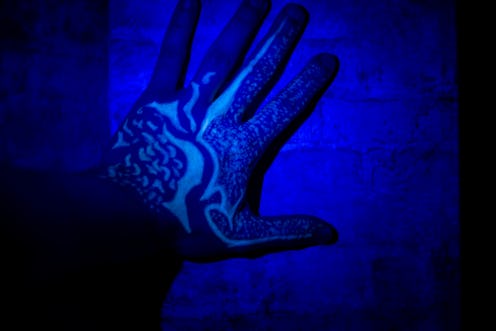Beauty
The Unfiltered Truth About Black Light Tattoos, Straight From A Pro
Here’s what you should know before getting black light ink.

Maybe you love all things glow-in-the-dark or maybe you just love having a secret. Whatever the reason, if you’re considering getting a UV tattoo — aka a tat with ink that’s only visible under a black light — there are a few things to know before making the leap. Black lights are also known as ultraviolet (UV) lights, and are often found in settings like nightclubs and raves. Black light tattoos are created using UV-reactive ink, which makes it nearly invisible in plain daylight, but visible under an ultraviolet bulb.
These transfixing tats aren’t new: Tattoo artist and co-owner of Brooklyn Tattoo Adam Suerte says UV and glow-in-the-dark tattooing gained popularity in the ‘90s, likely due to the craze for all things raves and neon. “This seemed a natural fad with the emerging counterculture,” he tells Bustle. Still, UV tattoos haven’t totally faded out of the scene, with celebrities like Zayn Malik and Lil Wayne sporting them.
Related: Everything To Know About Getting A Finger Tattoo
What’s cool about black light tattoos is the creative, otherworldly twist they can add to your body: The UV ink can be used to highlight specific parts of a tattoo done with traditional ink or form the basis of an entire tattoo. And they can most certainly bring a dramatic flair to your going-out aesthetic (consider bringing a black light flashlight with you to happy hour). Whether you just want to add something subtle (but still fun and unique), or you’re toying with the idea of going for a full-on black light arm sleeve, read on for expert-backed advice, from the costs to the potential risks.
What Makes Black Light Tattoos Glow?
It’s exactly like getting a traditional tattoo, explains Suerte. “The area is shaved and cleaned, a stencil is usually applied — unless it’s ‘freehand,’ where the artist draws the design on the body — and the tattoo machine moves the needle up and down, rapidly depositing the ink under the skin.”
The only real difference, he adds, is that the tattoo artist uses a special ink that reacts to UV light. “Sometimes the UV ink is used alone or is incorporated with regular ink, where it looks like a normal tattoo in regular light, but has accents that glow under UV light.”
What Are The Potential Risks?
Suerte explains that when the trend first emerged in the ‘90s, UV and glow-in-the-dark inks included a mix of traditional inks with phosphorus — a carcinogen — in them. “These days,” he says, “you can find UV inks without phosphorous. They won’t glow in the dark, but they will react to UV light.”
Still, he notes that no tattoo inks, UV-reactive or not, are regulated by the FDA. “A lot of ink companies don’t offer a list of ingredients...some also have a printed notice on the product that disclaims responsibility for skin reactions, so buyer should beware and do some research.” The bottom line? Black light tattoos haven’t been around long enough to really understand any long-term effects or serious risks.
Does this mean you should avoid black light tattoos at all costs? Not necessarily. It just means that because UV ink is less commonly used, you should make sure the tattoo artist and shop you are working with are reputable and safe. Do your research before making any decisions.
How Long Does Do Black Light Tattoos Usually Take?
Black light tattoos take longer (and therefore, cost more) to ink on than traditional tattoos. “Most tattoos are priced by how long they take,” says Suerte. It’s no different when it comes to UV tattoos, which could take a shorter or lengthier amount of time depending on the size, the type of tattoo, and other factors. At the end of the day, “it’s pretty much up to the individual artist,” he adds.
What Kind Of Tattoo Artist Can Do It?
The guy who did your BFF's Jem & the Holograms tattoo may be awesome with traditional tattoo ink, but have *zero* experience working with UV ink which is sometimes thicker and harder to blend in with other pigments. That means you should find someone in your area who has proven chops to create black light tattoos, then get on his or her waiting list.
How Should I Care For A Black Light Tattoo?
Breathe a sigh of relief: Suerte says the aftercare for a black light tattoo is no different from a regular tattoo. “Every shop has varying care instructions,” he adds, but generally, you’ll be encouraged to keep it moist for the first four to five days with Neosporin or Aquaphor. Then, switch to a generic moisturizer when your tattooed skin begins to flake. Remember to keep it out of the sun and avoid submerging the area underwater for the first two weeks, he advises.
How Long Do UV Tattoos Last?
UV ink typically lasts as long as regular tattoo ink, according to Suerte. As well, black light tattoos will “get normal wear-and-tear and eventually fade a bit (and may need touch ups).” Like regular tattoos, he adds, they are permanent, but how long — and well — they’ll stand the test of time depends on several factors, like “how good the tattoo artist is, how well the client takes care of it while it’s healing, and if they keep it protected from the sun.”
This article was originally published on